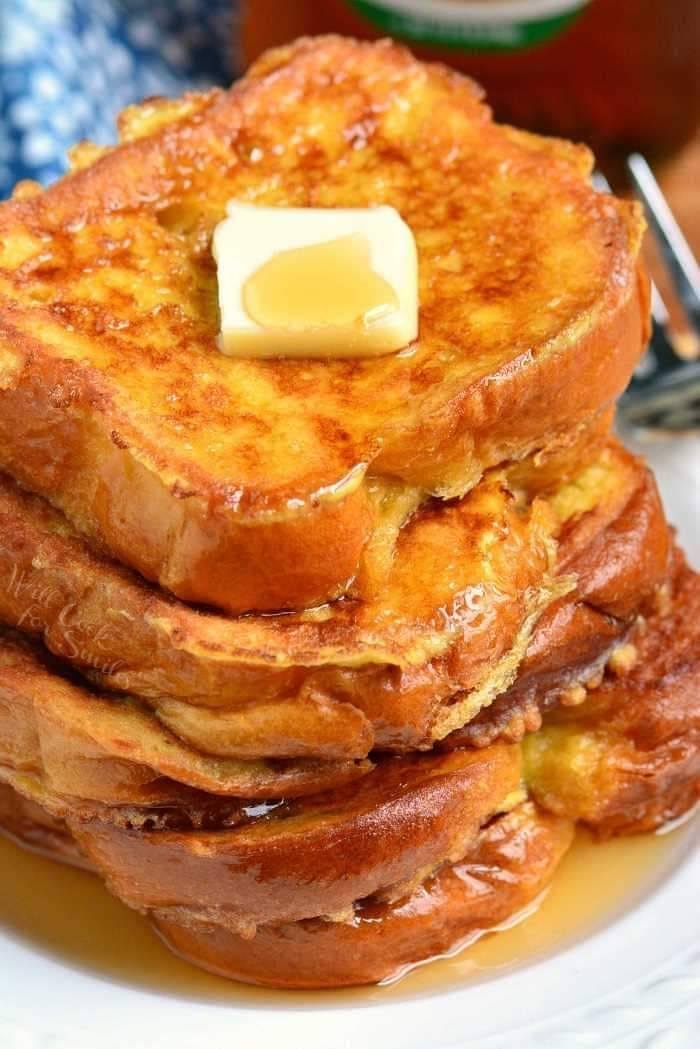ADVERTISEMENT
Instructions:
1. Prepare the Egg Mixture
In a shallow dish, such as a wide bowl or pie plate, crack the eggs and whisk them together with the milk, vanilla extract, cinnamon, and salt. The cinnamon adds a warm, comforting spice to the custard, while the vanilla brings a lovely aroma. Whisk until the mixture is smooth and well combined.
2. Choose the Right Bread
The key to perfect French Toast is using the right bread. Opt for a thick, slightly stale bread that can absorb the custard without falling apart. Brioche and challah are excellent choices because they’re soft, buttery, and slightly sweet. If you’re using fresh bread, you can always leave it out for a few hours to dry out a bit, which helps it absorb more of the egg mixture.
3. Dip the Bread
Heat a large skillet or griddle over medium heat. Melt a tablespoon of butter in the pan. While the butter is melting, dip each slice of bread into the egg mixture. Let the bread soak for about 5 seconds on each side, ensuring that it’s well coated but not too soggy. The bread should be moist, but not dripping.
4. Cook the French Toast
Once the butter is melted and sizzling, add the soaked bread slices to the pan. Cook for about 3 to 4 minutes on each side, or until golden brown and slightly crispy. You may need to adjust the heat to prevent burning, so keep an eye on the toast as it cooks. Flip the bread gently with a spatula to avoid splashing the egg mixture.
5. Serve and Enjoy
Once the French Toast is cooked to perfection, remove it from the skillet and transfer it to a warm plate. Serve immediately with your favorite toppings—whether that’s a drizzle of maple syrup, a dusting of powdered sugar, fresh berries, or whipped cream.
Tips for the Best French Toast:
- Use Day-Old Bread: Fresh bread is too soft and can become soggy quickly. Day-old or slightly stale bread is ideal because it soaks up the custard without falling apart.
- Adjust the Thickness: If you prefer thicker French Toast, use bread that is sliced a little thicker, or double-dip your bread for extra custard coverage.
- Add a Dash of Spice: While cinnamon is classic, you can also experiment with a pinch of nutmeg, allspice, or even a splash of orange zest for extra flavor.
- Don’t Overcrowd the Pan: Make sure not to overcrowd your skillet. Cooking in batches ensures that each slice gets that crispy, golden crust.
- Keep It Warm: If you’re making a large batch, you can keep the French Toast warm by placing the cooked slices on a baking sheet in a low oven (around 200°F) while you finish cooking the rest.
Variations and Toppings:
- Stuffed French Toast: Try stuffing your French Toast with cream cheese and fruit preserves for a decadent twist. You can even add chocolate chips or Nutella for a more indulgent breakfast.
- Savory French Toast: For a savory version, omit the sugar and vanilla in the egg mixture. Instead, season with salt, pepper, and fresh herbs. You can even add cheese or crispy bacon inside.
- Vegan French Toast: For a dairy-free and egg-free version, substitute the eggs with a mixture of flaxseed meal and water (1 tbsp flaxseed meal + 2 tbsp water per egg), and use almond milk or oat milk.
Conclusion:
Perfect French Toast is all about balance—the perfect golden crust, a soft and creamy inside, and the ability to pair with a wide variety of toppings. Whether you keep it simple or go all out with extras, French Toast is a dish that brings warmth and comfort to your breakfast table. Now that you know how to make it just right, go ahead and indulge in this delicious classic anytime you’re craving a special breakfast. Enjoy!
ADVERTISEMENT
